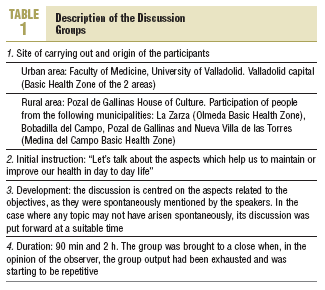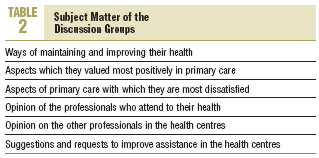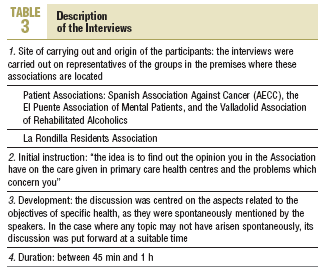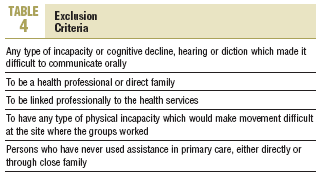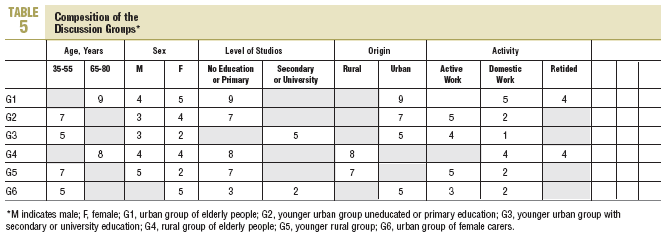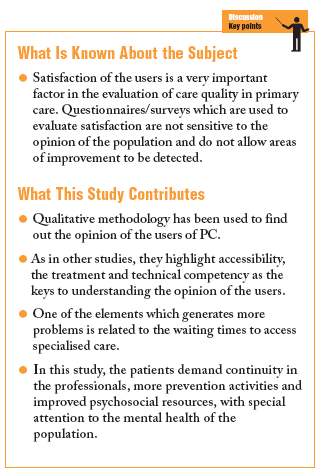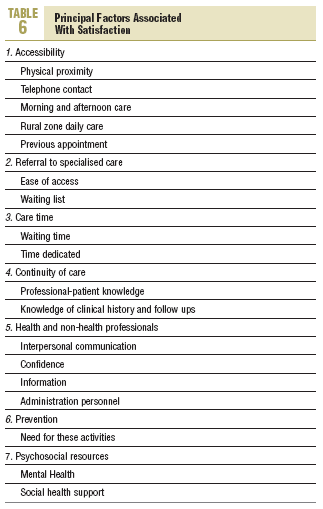Introduction
The primary care (PC) model has been continually improving since its introduction,1,2 although there are still important challenges ahead. The quality of health care concerns the users, professionals and managers, who are the principal route for improving the services. Among the different concepts of quality (quality control, guarantee of quality, quality management, and total quality), satisfaction is one of the most important factors to take into account,3-5 as is highlighted in the European Model of Excellence (EFQM).6-9 For this reason, to go into depth into the opinion of the users, their needs and expectations, from the perspective of perceived quality10,11 is of great importance. Also, it must not be forgotten that satisfaction is currently considered as part of the results of health care.12,13
However, in many of the satisfaction surveys, high marks are obtained which do not correspond to the feeling of the population5 and they do not identify the problems. Qualitative methodology enables these aspects to be examined in detail and understood14-19 by the identification of new areas of improvement in the services and by analysing new aspects to optimise satisfaction surveys.1,16
The objective of this study has been to analyse the opinions and expectations of the users on the care that they receive in PC and to identify the principal areas related with satisfaction.
Patients and Methods
Design
Qualitative methodology is the most suitable for covering the objectives of the study.20 These designs are constructed as the investigation process advances, gathering the different views and perspectives of the participants in the study.21,22 Thus focal groups and their Spanish variant, discussion groups, have been used in several studies on satisfaction.1,15,23,24 Using the interaction of the discussions of the participants, who tend to represent the social groups that express them,23,25,26 information of interest is generated.1,16 The most important points in the development of the groups are indicated in Table 1. The thematic guide used by the preceptor is shown in Table 2. Lastly, we should point out that each group had an observer.
Additionally, interviews were carried out27,28 with people from different associations (Table 3) who could have a particular view of PC.
Sample and Participants and/or Contexts
The sample design is structural and was carried out according to the most important variables of the social structure (which influences the discussions) in relation to the objectives. Also, the interviews were carried out on people from the most important nursing associations of Valladolid and the most influential residents association (Table 3).
The variables considered in the design of the profiles which should be included in the groups have been:
1. Age. Influences the opinions and appraisals,12,13 also, it is related with the use of the health services. People between 35 and 80 years participate, as they are the ones who use the health services most,28 separated into 2 age intervals (35-55 years and 65-80 years), since from 65 years the chronic diseases increase and, therefore, the use of the health services.28
2. Sex. The social differences between men and women influence their opinions, their values and even in the use of the health system.13 Also, many women are carers of some family member,29 which can involve different types of health care needs from the rest of the population.30,31
3. Place of residence. Living in a rural or urban environment has an effect on accessibility and the type of services received and, therefore, on satisfaction.12
4. Educational level. Educational level has been considered as an acceptable indicator of social class,33 and these are aspects which influence satisfaction.12
5. Activity. Active work, domestic work, retirement. The type of activity carried out is also associated with the access to and the use of health services.
Exclusion criteria (Table 4) have been taken into account for the composition of the groups, as well as a minimum of homogeneity and heterogeneity to guarantee discursive output and eliminate blocks. The composition of the groups is described in Table 5.
Recruitment of Participants
This was carried out by the snowball effect method or a recruitment network using consecutive steps. Contact is made with people with social connections in different environments and with local government social workers. The health service network was not used to avoid biases in the selection or the discussions of the users.
Analysis
The discussion generated was recorded on magnetic tape, with the previous consent of the participants, and subsequently transcribed literally. The analysis and the interpretation of the information were carried out independently by 2 investigators, who had meetings to contrast and discuss the material analysed. Firstly, they repeatedly read the texts and noted the possible significances. Afterwards the most representative sayings and phrases were selected, and the information categories were listed, grouped and identified. These were subsequently structured into the information focal points which take into account the perspectives of the users, from the understanding of the significances and directions contained in their discussions.
Results and discussion
The field work was carried out between February and June 2003. The most important aspects related to satisfaction are described below (Table 6).
Accessibility
One of the aspects most valued by the participants is the accessibility to the health services.1,5,24,33,34 They highlight as the most important, physical proximity, the ease of telephone contact, and the morning/afternoon opening times of the clinics.
"But if you weren't so far away, it would be accessible" (G2).
"...there are times it is not so, because you call and call and you are saying; what are the telephonists doing that they cannot pick up the telephone?..." (G6).
The informants have a positive opinion of the previous appointment, since it allows for better organisation and helps the professional to access the clinical history. However, this perception is maintained even although the appointment may be given for the same day.
"Its fantastic, but not when they tell me: come the day after tomorrow" (G2).
In rural areas, daily medical care is considered as very important and determines the difference in opinion between the people who rely on this resource and those that do not.
"We have, for example, the family doctor every day here, at home, which is not like other rural villages, where the doctor comes once a week" (G4).
Referring to Specialised Care
From the discussion, it arose that one of the basic functions of PC is to channel the patient to specialised care. Satisfaction seems to be related with better availability and speed of the professional to refer, when the health problem does not show a clear improvement.
"For me, the family doctor is the one who has to raise the alarm and send you to the specialist because they do not have the means, but they already see that it can be something and advise" (G5).
In this sense and as in other studies,34,35 the most frequent complaint centres on the waiting lists to access specialised care.
"That is the problem, that...they take so long from when you are poorly until they call you so that you can be seen" (G2).
Care Time
Overcrowding5,33,36 has an affect on other aspects of satisfaction, such as the waiting time in the clinics35 and the time dedicated to the patient by the professionals. Opinions centre on the incompatibility between quality and speed.
"In PC they have little time to dedicate to patient and often the patient requires more, because often it is not so much the illness but care of the soul" (AECC).
The waiting time is less in the rural environment. However, the users have the perception that they normally wait longer than is desirable, before entering the clinic.
"It is not as if it such a big village to have to wait so long; there are times when it is half an hour" (G4).
Continuity in the Carers
The users put great value on the continuity of the carers, although it is a rarely indicated variable.33 On the one hand, reference is made to the professional-patient mutual understanding in the framework of a good relationship, since when the professional changes, costs related to the need to adapt and interconnect are generated.
"The person who has been many years with you, gives you more confidence" (G4).
Another aspect is the use of clinical history.1 Much importance is given to that the professionals know the history of the patients and it contains a rigorous follow up of the illnesses, the risk factors, the treatments and tests carried out.
"The good thing that I see in our doctor is this, that an injection or something he gives you, immediately he writes it down and gives you a thorough check-up" (G5).
Health and Non-Health Professionals
One of the aspects most highlighted by the users is relative to the professional-patient relationship, and is one of the questions referred to most in other studies.24,33-35,37 Kindness, interest, personalised attention, listening and empathy are valued both in health and non-health professionals, that is, the variables which humanise care, although these points appear to be associate to the need for technical competence on the part of the professional.
"In the end what you want is for them to listen to you; when I go down with a problem, what I want is for them to listen to me and if you haven't been listened to and you are given a lot of medicines, it has no value for me" (G2).
The capacity of the professionals to provide clear and useful information is another valued aspect.
"If it is a person with some experience, and knows how to explain things to you, who understands you a little, who knows how to guide you" (G2).
Confidence is one of the words which appears most often in the different conversations analysed and is presented as a cornerstone. When patients perceive confidence, they arrive at the health services more relaxed and secure.
"The patient, to be cured, has to confide in the doctor; if you go there with distrust..." (G5).
There are complaints about the way the administrative staff treats the users. The importance of their function as the key to accessing the system is also recognised. For the informants, the work of these professionals in offering basic information, facilitating the passage through the health system, clarifying doubts, etc, is totally unquestionable.
"And they are the first point of entry so that the patient can be well attended, and if it is a old person you have to explain things or make the numbers so that they can be seen without glasses or more evident, in such a way that later they don't have to call you stupid for not knowing that the appointment was for 5.30 instead of 6.30" (G2).
Prevention
On this aspect, they consider that the activities and messages on prevention are essential in primary health care,5,13 but this role is not sufficiently covered.
"Real prevention, where every year they might give you a check-up which is due, where you might waste 2 hours or an hour and a half once a year and you don´t have to arrive at..., or the least possible" (GUJB).
Psychosocial Resources
The participants saw gaps and shortages in relation to psychosocial resources, particularly those which dealt with mental health. This problem is emphasised in the discussions by people who, due to their situation or belonging to some association, might have experienced the need to have support of this type and the lack of response given by the health services.
"In primary care there is no specific service for the early detection of mental illness and, of course, we need this shortage from our associations" (Asociacion El Puente).
Conclusions, Usefulness, and Limitations
The opinions of the participants centre on 3 pillars which constitute the basis of satisfaction/dissatisfaction. Firstly, and coinciding with the results from other studies,24,33,34,35 we find the structural and organisational aspects which determine access to the specialised care services, waiting lists and the continuity of care.
Secondly, the treatment received from the professionals who attend the patients is valued. In particular, as regards health personnel, technical competency, the relationships with the patients based on kindness, listening and empathy, the offering of clear information39 and adapted to the different needs, are the most prominent aspects. These variables are also shown to be central in other studies.24,33-35,37,40,41 In this sense, undergraduate and postgraduate training in the field of interpersonal communication is needed to improve and humanise the health services.
The third aspect refers to the lack of some services, such as those concerning prevention programs in some age groups,5,33 mental health services and the response to psychosocial type needs, as in the case of women who look after dependent patients and which have been demonstrated in other studies.42,43
In conclusion, the need to carry out changes in the organisation and management to improve the use of available resources, investment in new human and material resources, the simplification of procedures and better employment stability which favours the continuity of the professionals, is noted. On the other hand, it is necessary to create mechanisms of analysis and reflection which redefine the model of the relationship between professionals and patients, considering the political, social and cultural variables that this entails.
Therefore, the use of qualitative methodology has been interesting and valuable to obtain the views of the users and identify areas of improvement associated with satisfaction, as is recommended in other works.34,44,45
Lastly, it important to stress that the study does not deal with the opinion of more specific groups (immigrants, gypsies, young people). Also it has to be taken into account, on interpreting the results, the possibility that it may have produced a positive bias in the opinion of the participants, since quite a lot of resistance to take part has been encountered.15,33 To improve the validity, the analysis of the results was carried out by 2 investigators and it has tried to maximise the diversity of opinions according to the structural variable, achieving saturation of the discussion in the groups formed, and the profiles and the results have been described in a way that they could apply in similar contexts. However, we must not forget that the results cannot be extrapolated to other population groups, but they might be applicable to populations similar to those studied.





